There is a place on the Alaska Peninsula southwest of Anchorage named Geographic Harbor (58° 6.174' N, 154° 35.425' W, west of Kodiak Island) that is justly famous for its population of bears. This was my second visit to a place where, regarding large mammals, people are the minority species in every sense of the word. At one point I slowly rotated my kayak in the middle of the bay and counted 22 brown bears (grizzlies) visible at once. Nearly speechless, I think I said something really intelligent like "wow" and hoped I didn't have to go ashore for any reason (among that large a bear population, someone would surely have had me for breakfast).
Mama bear and cubs out clamming.
The brat pack — a group of underweight, inexperienced, predatory
teenage bears. They pretend to be clamming, but there are no clams in
those rocks, amd mama bear knows this is a ruse (bears do not normally
run in packs, but teenagers sometimes do, just like humans).
Mama bear creates the maximum threat display
(I wish I could have recorded the sounds). Her cubs join in.
The brat pack runs away, discouraged by the display of resolve, still hungry.
During last year's visit I met a mama bear and three first-season cubs. After a short spell of uncertainty, mama bear had accepted my presence and she signaled this by nursing her cubs right in front of me. During the winter I thought about mama bear and her cubs — that is a lot of responsibility and a tempting target for the many older male bears who have no moral qualms about predating on cubs. Would I see the bear family again? Would they survive the winter?
In a word, yes. Pretty soon after my arrival this year I saw mama bear and her entourage on shore, her three cubs now much larger yearlings. And then I realized something else — after she noticed and accepted me again, mama bear seemed to be trying to stick close to me. I would paddle along the shore of the bay, then mama bear would follow me with her cubs in tow. I quickly realized this was because the larger male bears are terrified of humans (grizzly bears are pursued by trophy hunters who collect their skins and leave the bear behind), and mama bear does all she can to keep her cubs away from the males, who are the biggest threat to her cubs. So it is pragmatic to stick close to a human. It makes sense, it speaks to the intelligence of bears, and I have had this observation confirmed by other people with bear experience.
Then, as though on cue, I watched three teenage bears, running as a pack, try to attack the bear family. This was the only time on this voyage when I really needed a moving record of the events. Most of the time a TV camera is more hassle than it's worth, and cannot record very much detail, but for about five minutes, I wished I had one. The sequence of images at the right will have to do.
As the teenage bear pack approached the family, mama bear moved her cubs away, eventually right to the water's edge. I watched this and wondered why she was allowing herself to be cornered near some cold, deep water. Wasn't this more dangerous than moving along shore? Then I realized what was going on — she was actually moving her cubs as close as possible toward me!
It took me a while to realize this because of how I see myself while I'm in bear country. When I visit bears I picture myself as an invisible, harmless witness, not a player, not an actor in a drama. I don't hunt, I don't try to get the bears to perform tricks, I have a silent camera and a silent boat. I'm as invisible as it is practical to be, and still be there. But mama bear saw it differently — she had backed up to shore, had minimized the distance between herself and me, she spent the entire time facing the approaching threat, not looking toward me at all. It was obvious — whether I wanted to be or not, I was on her side. And in the natural world there are no non-participants, no impartial witnesses, there are only sides, and you either choose a side or you have a side chosen for you.
You might think I reacted to this by raising a ruckus, yelling at the attacking bears, accepting my place as mama bear's protector. But I didn't do that, for the same reason one must never feed bears. I knew it would be wrong to allow mama bear to get too comfortable with humans, to come to depend on us for anything important. If I could have spoken to mama bear, I would have told her I was a witness, a traveler, here today, gone tomorrow, not dependable. I would have told her, even though she trusted me, people cannot be trusted.
When I imagined encountering bears many years ago, before I had any direct experience, I thought how exciting (and how scary) it would be to meet a bear face to face. Now I know there is another, deeper level to bear encounters, one I can't put into words except to say it is like being embraced by nature: it is to have a bear meet you, get comfortable with you, then turn away from you in peace, confident that you are harmess. What I am saying is the thrill of standing in front of a bear (not in a zoo, but on equal terms, in the bear's domain) is nothing compared to standing behind one who knows you are there. He is aware of you, he can smell you, but you are accepted, he doesn't need to face you any more. You are not the hunter, the stranger — you are a forest dweller like him.
I now think the worst way to learn about bears is to read stories about bear attacks. It is true that bears are wild animals and might like to eat you if given a chance. But nothing educates you like spending time in close proximity to bears. Bears are basically peaceful creatures who want to be left alone. I think bears are smart, resourceful, curious, dangerous to us and each other when they are hungry or startled, but not innately mean-spirited, which is why they sometimes get into trouble with people, because people are in fact innately mean-spirited (just my opinion, remember). I think for a bear, the idea that someone would show up, shoot a bear, take its skin and leave the rest of the bear to rot, just wouldn't compute. That's why hunters can kill them.
|
A privileged position — behind a 500-pound bear who knows you are there, and who doesn't care.
|


 Share This Page
Share This Page

 Share This Page
Share This Page
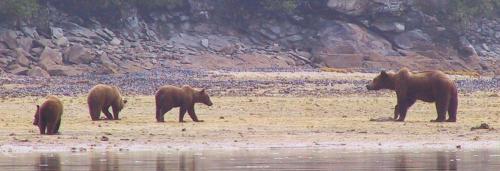
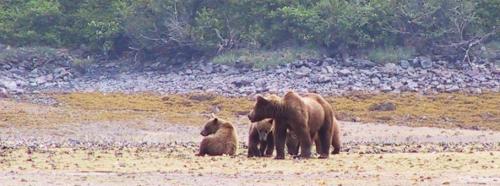
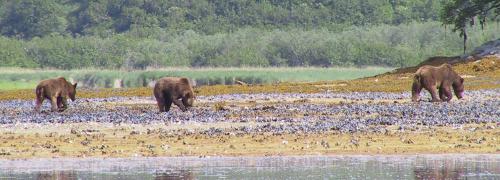
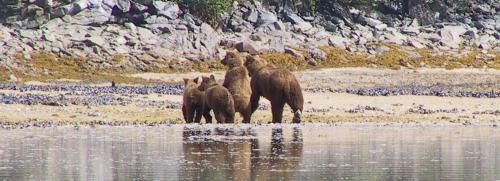
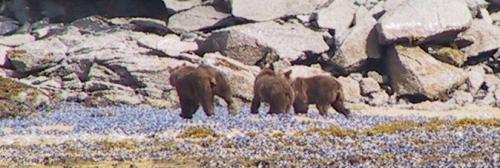
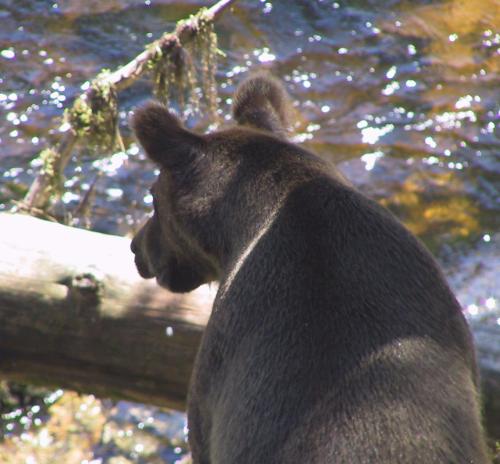


 Share This Page
Share This Page